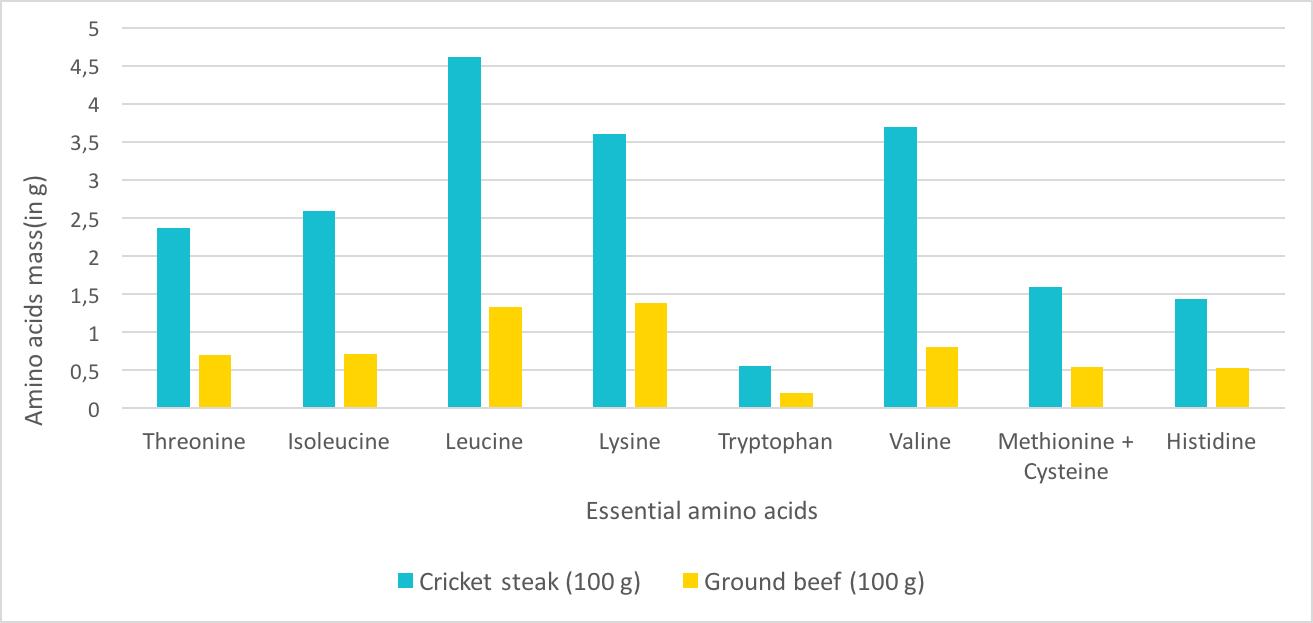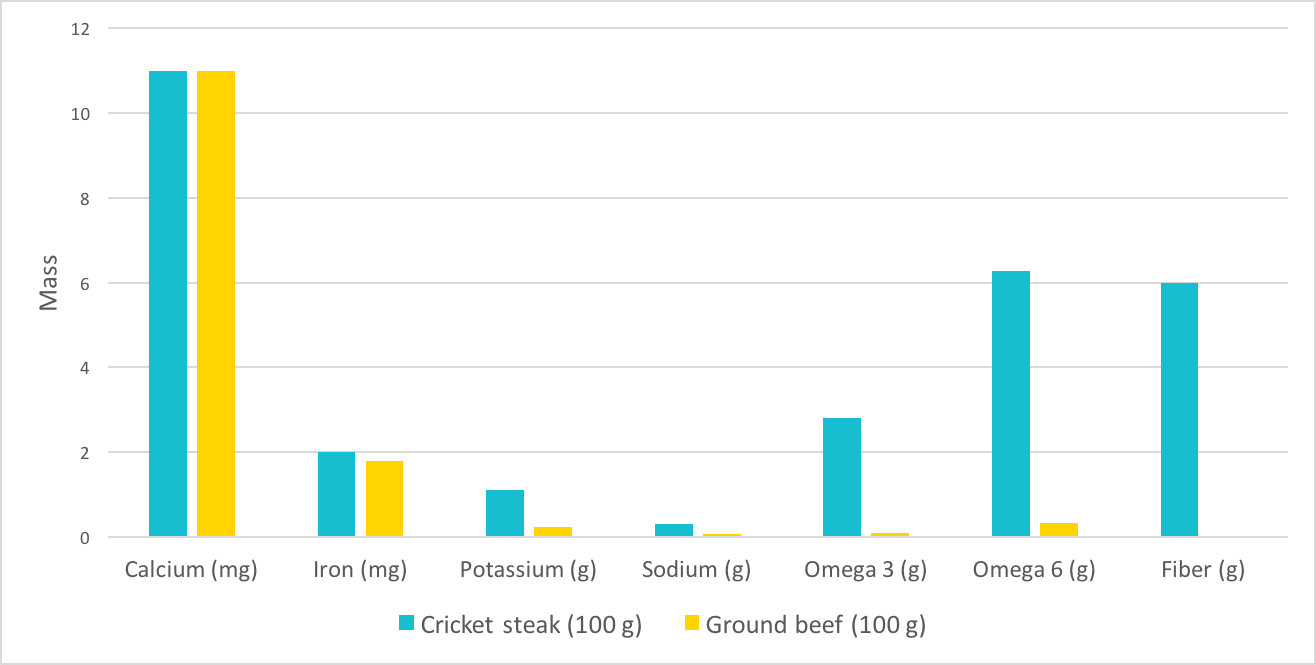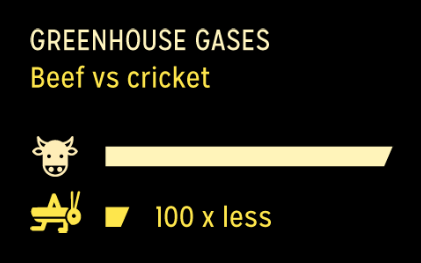"How about eating a steak for dinner? And why not a cricket steak for a change?" Imagine that you are in a restaurant... a special restaurant. On the menu, you can choose between the classic beef steak, but also, a cricket steak. What would be the advantages of choosing crickets rather than beef?
Nutritional properties
Let's start by comparing the nutritional properties offered by a 100g steak of ground beef compared to a steak made with 100g of crickets.
While red meat is often known to be a significant source of protein in our diet, it is interesting to note that crickets have a protein contentof about two to three times higher. Surprising right? Take a look at the chart below: 100g of chopped steak brings only about of 20g of protein against 60g for a cricket steak of the same weight.

Graph 1: Comparison of the macronutrients content in 100 g cricket steak versus 100 g ground beef
As mentioned in the protein article, protein quality is also an important factor to consider. Crickets, just like beef, are an excellent source of complete protein. Nevertheless, given their higher protein content, crickets provide more essential amino acids than beef on the same weight basis. Thus the cricket steak is much more profitable in terms of proteins offered.

Moreover, unlike beef, crickets provide us with dietary fibers, known for their beneficial effects on intestinal transit. The latter are present in significant quantity: 6g per 100g of insect, which represents more than 20% of the recommended daily dietary intake (Health Canada recommends a daily intake of 25 g for an individual aged from 18 to 50 years).
But that is not all: crickets also contain more potassium. This mineral is crucial within our body, as its main function is to maintain fluids and electrolytes balanceas well as cells’ integrity. Adequate intake of potassium notably helps reduce hypertension.
Finally, let's talk about omega-3 and omega-6. These two fatty acids are essential in our diet as our organism cannot synthesize them. Our body uses those molecules as a base to form other molecules necessary for the proper functioning of our cells. Because these two elements compete during the assimilation process, it is important to maintain a specific balance of each of the molecules. Crickets offer an ideal ratioof about 3: 1 (omega 6: omega 3) and in greater quantity than beef.

And from an environmental point of view?
Now let's take a look at the raising methods of cattle and crickets.
How do we raise cattle? It's quite simple: to caricature, you just have to give them lots ofwater, lots offood, and lots oftime. And what about crickets? These are breeded in very large numbers in a barn, and in less than 6 weeks they become adults. As an example, Entomo Farms, (our provider), uses a 60,000 square foot building hosting about 100 million crickets. Concerning their diet, they only need very small quantities of food and water.
Conversion of food into protein
First of all, crickets require about12 times less food than beef for the same edible weight gain. In fact, 2.4kg of fodder (food given to cattle) are necessary to produce 100g of beef, against 200g of food for crickets.

One quickly understands why two-thirds of the cultivated surfacesare used for animal production... And yet, we must take into account thephytosanitary products (substances used to treat or protect the plant against pathogenic organisms) andfuelused to grow these forage crops. In this regard, the cricket is clearly the winner!
Water consumption
But it's not over! The estimated amount of water needed to produce 100g of beef is about2200L, taking into account the huge amount of water needed for forage crops. Yet, there is no accurate data available on this subject concerning crickets. However, according to estimations, the amount of water needed would be around 2000 times less.

Greenhouse gas emissions
Let's now look at greenhouse gas emissions. According to the 2013 FAO report concerning edible insects, livestock would be responsible for 18% of the emissions, which represent a larger sharethan the transportation sector. Cattle farming is responsible for the majority of it. In fact, the production of a 100g beef steak induces 750g greenhouse gases emission (CO2equivalent). The emissions related to the production of the same amount of crickets are estimated 100 times lesser... Well, that is quite a big difference.

Price
Now let’s talk about another important aspect :price. Because nowadays crickets are arare commodity, the laws of economics make them a relatively expensive food. On the other hand, beef has been raised on a large scale for several decades. Insects industry is still in its early stage, the production is not yet automated and as efficient as conventional farming. However techniques and tools are being developed to fill these gaps. Insect-based food will become more democratic with time and should become even more affordablethan beef.
For now, the cricket is more expensive than beef, but this will not last!
To conclude
To put it in a nutshell, as you may have noticed, crickets are an much moreeco-responsible than beef, and provide better nutritionalproprieties. Crickets contain 2 to 3 times more complete protein than a beef steak on the same weight basis. Crickets will also give you more iron, more vitamins, and more fiber. In addition, a cricket steak represents a huge ecological advantage, compared to a beef one. It has a smaller impact on the planet: its production requires 12 times less feed resources and about 2000 times less water. It is also at the origin of 100 times less greenhouse gas emissions. The cricket steak widely wins this face to face!
Until you find a cricket steak in your favorite restaurant, why not start with a Näak bar?








































Chris Nice
October 25, 2019
Yes indeed, crickets are by far so much better than beef, not only healthwise but environmentally too; however, the photo of the black and white cows depicts Holstein Friesian cows enjoying a meal in a barn. They are dairy cows, a different argument altogether. Cricket on! Chris Nice